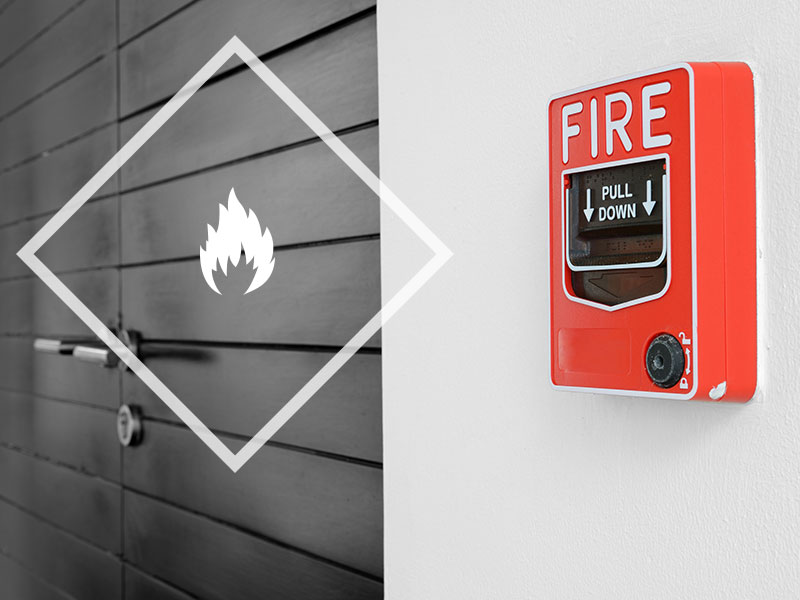The Anatomy of a Fire Alarm System: Essential Components for Complete Protection

Fire alarm systems serve as silent sentinels, safeguarding lives and property by providing critical early warnings in fire emergencies. Understanding their intricacies can empower individuals and organizations to make informed decisions about their fire safety needs. In this article, we’ll explore the key components of a fire alarm system and explain how they work together to ensure swift and effective responses when a fire strikes.
Fire Alarm Control Panel (FACP): The Command Center
At the heart of every fire alarm system is the Fire Alarm Control Panel (FACP). Often referred to as the control unit, this panel acts as the brain of the system. It constantly receives signals from various detectors installed throughout the building and decides on the appropriate action based on the information it receives. When a detector senses a potential fire, the FACP springs into action, initiating alarms, notifying emergency services, and providing real-time updates on the status of each zone within the system.
The FACP also serves as an interface for building managers, security teams, and emergency responders. It provides both visual and audible indicators that help assess whether a potential threat is real or false, and where in the building the issue is occurring. With modern fire alarm systems, FACPs can also be networked to provide remote monitoring, making it possible for facility managers to receive updates and alerts from anywhere. This kind of advanced technology significantly enhances response times and ensures a greater level of safety for building occupants.
Smoke Detectors: Early Warning Pioneers
One of the most critical components of any fire alarm system is the smoke detector. These devices are designed to identify the presence of smoke particles in the air, often one of the first signs of a fire. Smoke detectors come in two main types: ionization detectors and photoelectric detectors.
- Ionization Smoke Detectors: These are highly sensitive to fast-burning fires, such as those that involve flammable liquids. When ionized particles are present in the air, these detectors quickly sense them, triggering an alarm.
- Photoelectric Smoke Detectors: More effective at detecting smoldering fires, such as those that might develop slowly in upholstered furniture or carpets. Photoelectric detectors use a beam of light to detect smoke particles in the air.
By installing a combination of both types of smoke detectors, property owners can ensure they are protected against a wide variety of fire threats. Smoke detectors are typically installed in key areas of a building, such as hallways, living rooms, and near bedrooms in residential properties, as well as in offices, meeting rooms, and common areas in commercial buildings.
Heat Detectors: Sensing Temperature Surges
While smoke detectors are effective in many situations, heat detectors play a crucial role in environments where smoke detection might lead to false alarms. For example, in kitchens, garages, or mechanical rooms where smoke or steam may not necessarily indicate fire, heat detectors can be more reliable.
There are two primary types of heat detectors:
- Fixed Temperature Detectors: These activate when the ambient temperature reaches a specific pre-set level, usually indicating a fire.
- Rate-of-Rise Detectors: These detectors are triggered when there is a rapid increase in temperature, signaling the possibility of a nearby fire.
Because heat detectors focus on temperature changes rather than airborne particles, they provide essential protection in environments where smoke detection might not be practical. In many cases, a well-designed fire alarm system will incorporate both smoke and heat detectors to ensure comprehensive coverage.
Fire Alarm Notification Devices: Audible and Visible Alerts
Once a fire is detected, the next step is alerting the building’s occupants so they can evacuate as quickly as possible. Fire alarm notification devices play a crucial role in this phase, offering both audible and visual warnings.
- Audible Alarms: These include devices like horns, bells, and sirens, which sound loudly to ensure everyone can hear the alarm, regardless of their location in the building.
- Visible Alarms: For individuals who may have hearing impairments or in noisy environments, visual alarms like flashing strobe lights are essential. These alarms are typically synchronized with audible alarms to provide a cohesive warning system.
By combining both types of notifications, fire alarm systems ensure that all building occupants, regardless of physical limitations or distractions, are aware of the danger and can take appropriate action.
Manual Pull Stations: Empowering Occupants
In addition to automatic detectors, fire alarm systems also include manual pull stations. These are designed to allow individuals to manually trigger the fire alarm system in the event of a fire. Usually located near exits and other accessible areas, these pull stations provide a simple way for occupants to alert others to the presence of a fire.
Manual pull stations are a crucial component of fire alarm systems, as they give individuals the power to respond to a fire even if automatic detectors have not yet been triggered. In high-traffic areas, placing pull stations near exits ensures that people can easily activate the alarm system as they evacuate the building.
Duct Smoke Detectors: Safeguarding Ventilation Systems
In commercial buildings, duct smoke detectors are a vital component of the fire alarm system. These devices are installed in the HVAC (Heating, Ventilation, and Air Conditioning) ductwork and monitor air circulation for signs of smoke.
If smoke is detected within the ducts, the duct smoke detectors will trigger the fire alarm system and, in most cases, automatically shut down the HVAC system to prevent smoke from spreading throughout the building. This feature is particularly important in large buildings, where the ventilation system could quickly carry smoke from one area to another, making evacuation more difficult.
Monitoring Modules: Enhancing System Intelligence
Fire alarm systems can also be customized to monitor additional hazards, such as water flow from sprinklers or the presence of dangerous gases. Monitoring modules integrate these specialized detectors into the fire alarm system, enhancing its ability to respond to a variety of emergencies.
For example, a water flow switch can detect when a sprinkler system is activated, allowing the fire alarm control panel to alert building occupants even if the fire itself has not yet triggered the smoke or heat detectors. Similarly, gas detectors can identify dangerous gases such as carbon monoxide, adding an extra layer of safety for building occupants.
Backup Power Supply: Ensuring Continuous Operation
A fire alarm system is only as effective as its ability to operate under all conditions, including power outages. To ensure uninterrupted functionality, fire alarm systems include backup power supplies, typically in the form of batteries or generators. These backup systems keep the fire alarm system operational even when the building’s primary power source is compromised, providing critical protection during emergencies.
Most fire codes require that backup power systems be able to sustain a fire alarm system for at least 24 hours. This redundancy ensures that the system remains reliable, even in the most challenging conditions.
Conclusion: A Symphony of Safety
Fire alarm systems are much more than a collection of devices; they are a carefully orchestrated symphony of safety. Each component, from the Fire Alarm Control Panel to smoke detectors, heat detectors, and manual pull stations, plays a vital role in protecting lives and property. Together, they provide a comprehensive system that can detect fires, alert building occupants, and facilitate a safe evacuation.
Whether you’re a building owner, facility manager, or resident, understanding these components allows you to appreciate the complexity and importance of fire alarm systems. To ensure that you have the best possible protection, contact WSS Integrated Technologies for expert guidance on the fire alarm system that suits your specific needs. Let our team of professionals help you navigate the world of fire safety and ensure that your property and the people in it are protected.
- The Role of Continuous Monitoring and Analysis in Intrusion Detection - September 6, 2024
- Understanding Crucial Terms and Technologies in Fire Alarm Systems - August 30, 2024
- The Anatomy of a Fire Alarm System: Essential Components for Complete Protection - August 23, 2024
